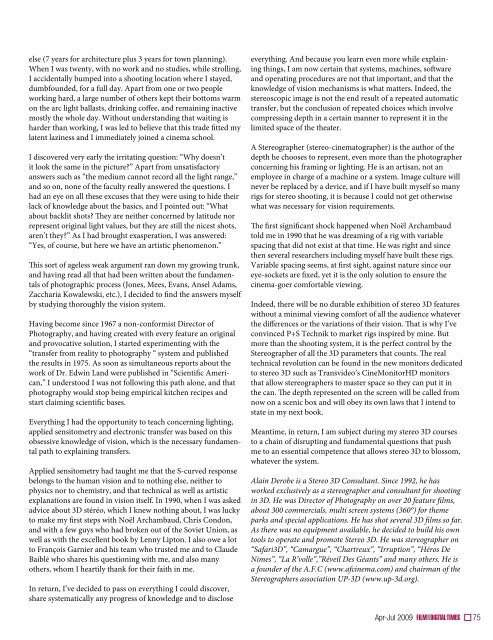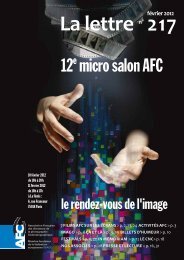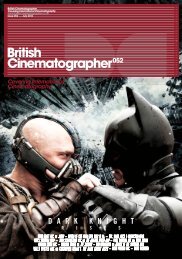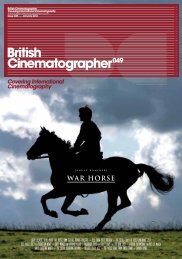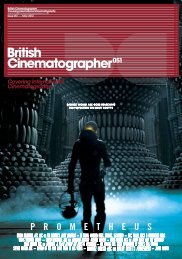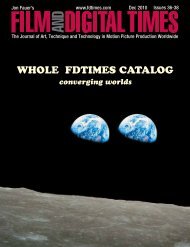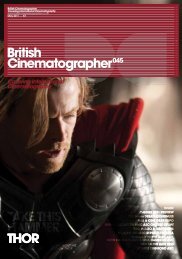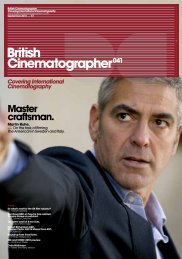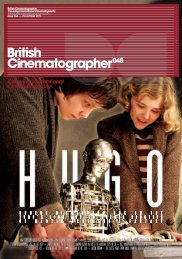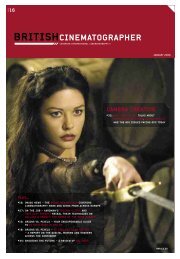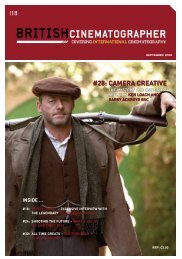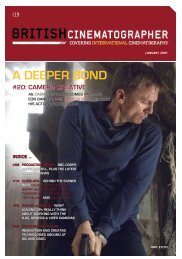Create successful ePaper yourself
Turn your PDF publications into a flip-book with our unique Google optimized e-Paper software.
else (7 years for architecture plus 3 years for town planning).<br />
When I was twenty, with no work and no studies, while strolling,<br />
I accidentally bumped into a shooting location where I stayed,<br />
dumbfounded, for a full day. Apart from one or two people<br />
working hard, a large number of others kept their bottoms warm<br />
on the arc light ballasts, drinking coffee, and remaining inactive<br />
mostly the whole day. Without understanding that waiting is<br />
harder than working, I was led to believe that this trade fitted my<br />
latent laziness and I immediately joined a cinema school.<br />
I discovered very early the irritating question: “Why doesn’t<br />
it look the same in the picture?” Apart from unsatisfactory<br />
answers such as “the medium cannot record all the light range,”<br />
and so on, none of the faculty really answered the questions. I<br />
had an eye on all these excuses that they were using to hide their<br />
lack of knowledge about the basics, and I pointed out: “What<br />
about backlit shots? They are neither concerned by latitude nor<br />
represent original light values, but they are still the nicest shots,<br />
aren’t they?” As I had brought exasperation, I was answered:<br />
“Yes, of course, but here we have an artistic phenomenon.”<br />
This sort of ageless weak argument ran down my growing trunk,<br />
and having read all that had been written about the fundamentals<br />
of photographic process (<strong>Jon</strong>es, Mees, Evans, Ansel Adams,<br />
Zaccharia Kowalewski, etc.), I decided to find the answers myself<br />
by studying thoroughly the vision system.<br />
Having become since 1967 a non-conformist Director of<br />
Photography, and having created with every feature an original<br />
and provocative solution, I started experimenting with the<br />
“transfer from reality to photography “ system and published<br />
the results in 1975. As soon as simultaneous reports about the<br />
work of Dr. Edwin Land were published in “Scientific American,”<br />
I understood I was not following this path alone, and that<br />
photography would stop being empirical kitchen recipes and<br />
start claiming scientific bases.<br />
Everything I had the opportunity to teach concerning lighting,<br />
applied sensitometry and electronic transfer was based on this<br />
obsessive knowledge of vision, which is the necessary fundamental<br />
path to explaining transfers.<br />
Applied sensitometry had taught me that the S-curved response<br />
belongs to the human vision and to nothing else, neither to<br />
physics nor to chemistry, and that technical as well as artistic<br />
explanations are found in vision itself. In 1990, when I was asked<br />
advice about 3D stéréo, which I knew nothing about, I was lucky<br />
to make my first steps with Noël Archambaud, Chris Condon,<br />
and with a few guys who had broken out of the Soviet Union, as<br />
well as with the excellent book by Lenny Lipton. I also owe a lot<br />
to François Garnier and his team who trusted me and to Claude<br />
Baiblé who shares his questioning with me, and also many<br />
others, whom I heartily thank for their faith in me.<br />
In return, I’ve decided to pass on everything I could discover,<br />
share systematically any progress of knowledge and to disclose<br />
everything. And because you learn even more while explaining<br />
things, I am now certain that systems, machines, software<br />
and operating procedures are not that important, and that the<br />
knowledge of vision mechanisms is what matters. Indeed, the<br />
stereoscopic image is not the end result of a repeated automatic<br />
transfer, but the conclusion of repeated choices which involve<br />
compressing depth in a certain manner to represent it in the<br />
limited space of the theater.<br />
A Stereographer (stereo-cinematographer) is the author of the<br />
depth he chooses to represent, even more than the photographer<br />
concerning his framing or lighting. He is an artisan, not an<br />
employee in charge of a machine or a system. Image culture will<br />
never be replaced by a device, and if I have built myself so many<br />
rigs for stereo shooting, it is because I could not get otherwise<br />
what was necessary for vision requirements.<br />
The first significant shock happened when Noël Archambaud<br />
told me in 1990 that he was dreaming of a rig with variable<br />
spacing that did not exist at that time. He was right and since<br />
then several researchers including myself have built these rigs.<br />
Variable spacing seems, at first sight, against nature since our<br />
eye-sockets are fixed, yet it is the only solution to ensure the<br />
cinema-goer comfortable viewing.<br />
Indeed, there will be no durable exhibition of stereo 3D features<br />
without a minimal viewing comfort of all the audience whatever<br />
the differences or the variations of their vision. That is why I’ve<br />
convinced P+S Technik to market rigs inspired by mine. But<br />
more than the shooting system, it is the perfect control by the<br />
Stereographer of all the 3D parameters that counts. The real<br />
technical revolution can be found in the new monitors dedicated<br />
to stereo 3D such as Transvideo’s CineMonitorHD monitors<br />
that allow stereographers to master space so they can put it in<br />
the can. The depth represented on the screen will be called from<br />
now on a scenic box and will obey its own laws that I intend to<br />
state in my next book.<br />
Meantime, in return, I am subject during my stereo 3D courses<br />
to a chain of disrupting and fundamental questions that push<br />
me to an essential competence that allows stereo 3D to blossom,<br />
whatever the system.<br />
Alain Derobe is a Stereo 3D Consultant. Since 1992, he has<br />
worked exclusively as a stereographer and consultant for shooting<br />
in 3D. He was Director of Photography on over 20 feature films,<br />
about 300 commercials, multi screen systems (360°) for theme<br />
parks and special applications. He has shot several 3D films so far.<br />
As there was no equipment available, he decided to build his own<br />
tools to operate and promote Stereo 3D. He was stereographer on<br />
“Safari3D”, “Camargue”, “Chartreux”, “Irruption”, “Héros De<br />
Nimes”, “La R’volle”,”Réveil Des Géants” and many others. He is<br />
a founder of the A.F.C (www.afcinema.com) and chairman of the<br />
Stereographers association UP-3D (www.up-3d.org).<br />
Apr-Jul 2009<br />
75


